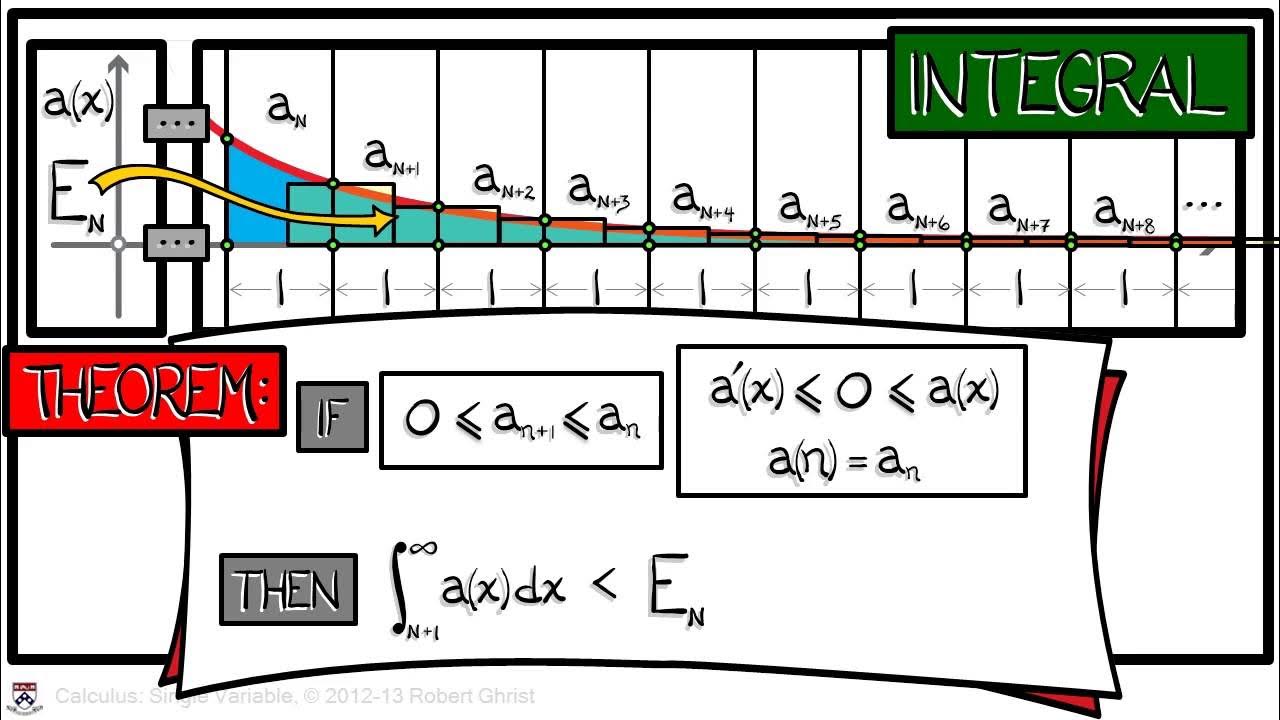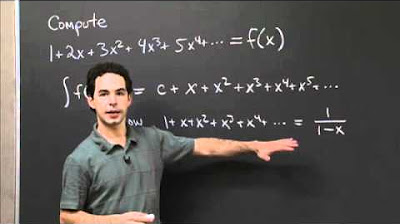Calculus Chapter 1 Lecture 6 Expansion Points
TLDRIn this calculus lecture, Professor Greist delves into the concept of Taylor series expansion at points other than zero, offering a broader understanding of its applications. He illustrates the process by deriving the Taylor series for the natural logarithm function centered at x=1, revealing the series' convergence domain and its limitations. The lecture also explores the importance of choosing the right expansion point for accurate approximations, exemplified through estimating the square root of 10 and the composition of functions. The session concludes with a teaser for the next lesson on limits, emphasizing the ongoing relevance of Taylor series in calculus.
Takeaways
- 📚 The lecture introduces the concept of changing the expansion point in Taylor series to focus on points other than 0 for function approximation.
- 🔍 The Taylor series of a function at a point 'a' is defined as a sum involving derivatives of the function evaluated at 'a', divided by increasing powers of 'k' factorial.
- 📈 The series is a polynomial in '(x - a)', with coefficients determined by the function's derivatives at point 'a'.
- 📝 The terms of the series are referred to as the zeroth, first, second, etc., order terms, correlating with the degree of the '(x - a)' term.
- 🔄 By defining 'h' as '(x - a)', the series can be expressed in terms of 'h', providing an approximation for 'f(a + h)'.
- 🌐 The domain of convergence for the Taylor series of the natural logarithm function is between 0 and 2, highlighting the importance of the expansion point for accuracy.
- 🧩 The example of computing the Taylor series for log(x) at x=1 shows a pattern in the coefficients and leads to a familiar series for log(1 + h).
- 🔢 The importance of the expansion point is further demonstrated by the example of estimating the square root of 10, where different points yield different approximation accuracies.
- 📉 When dealing with compositions, the correct expansion points for both the inner and outer functions are crucial for accurate Taylor series computation.
- 🔮 The example of the Taylor series for e^(cos(x)) at x=0 illustrates the process of expanding the composition correctly by focusing on the input to the exponential function.
- 🚀 The lecture concludes with a look forward to the next topic, the concept of limits in calculus, which will be explored with insights gained from understanding Taylor series.
Q & A
What is the primary focus of Lecture 6 on Taylor series?
-The primary focus of Lecture 6 is to explore the concept of changing the expansion point in Taylor series to approximate functions near points other than 0.
Why might we want to change the expansion point in a Taylor series?
-We might want to change the expansion point to approximate functions for inputs that are not necessarily close to zero, as is often the case in applications outside of finance and economics.
What is the general form of the Taylor series of a function F at x equals a?
-The general form is the sum from k=0 to infinity of the k-th derivative of F evaluated at a, divided by k factorial, times (x - a) to the power of k.
What is the significance of the term 'H' in the context of the Taylor series?
-The term 'H' is defined as (x - a) and is used to express the Taylor series as a polynomial series in H, which helps in approximating the function f for values close to 'a'.
What is the zeroth order term in the Taylor series?
-The zeroth order term is the constant term obtained by evaluating the function at x equals a.
How does the change of variables to 'H' affect the Taylor series?
-The change of variables to 'H' transforms the series into a polynomial series in 'H', which approximates f(a + h) instead of f(x).
What function is used as an example to demonstrate the computation of the Taylor series in the lecture?
-The natural logarithm function, log(x), is used as an example to demonstrate the computation of the Taylor series.
What is the pattern observed in the derivatives of the log(x) function when computing its Taylor series?
-The pattern observed is that the k-th derivative of log(x) is (-1)^(k+1) times (k-1)! divided by x^k, and when evaluated at x=1, it gives coefficients of (-1)^(k+1) times (k-1)!.
Why is the domain of convergence important when using Taylor series?
-The domain of convergence is important because it defines the range of x values for which the Taylor series provides a reasonable approximation of the function.
What is the significance of choosing the correct expansion point when estimating a function like the square root of 10?
-Choosing the correct expansion point is crucial because it minimizes the number of derivatives needed for an accurate approximation and ensures that the approximation is valid within the domain of convergence.
Why is it necessary to expand functions about the correct values when computing a Taylor series of a composition?
-It is necessary to expand functions about the correct values to ensure that the approximation is accurate. For a composition, the inner function must be expanded about the input x, while the outer function must be expanded about the value of the inner function at x.
What is the next topic to be covered after the introduction to Taylor series in the lectures?
-The next topic to be covered is the notion of a limit in calculus, which will be explored using the understanding gained from Taylor series.
Outlines
📚 Introduction to Expansion Points in Taylor Series
Professor Greist introduces the concept of changing the expansion point in a Taylor series to focus on a specific point other than zero. The lecture explains how Taylor series can be used to approximate functions near a chosen point 'a', leading to a broader definition of Taylor series. The formula for the Taylor series at a point 'a' is presented, highlighting the polynomial nature of the series in the form of (X - a). The explanation includes terminology such as the zeroth, first, second, and third order terms, which correspond to the degree of the (X - a) polynomial. An example of computing the Taylor series for the natural logarithm function at a point different from zero is provided, demonstrating the process of finding the series coefficients and the resulting series expansion.
🔍 Understanding the Importance of Expansion Points for Approximations
This paragraph delves into the significance of selecting the appropriate expansion point for Taylor series approximations. It emphasizes that the domain of convergence for the series is crucial for accurate approximations, with the example of the natural logarithm function showing how the domain affects the quality of the approximation. The paragraph also reviews different ways to conceptualize the Taylor expansion, including writing it as a series in (X - a) or in a new variable H = (X - a). The importance of knowing more derivatives of a function at a point 'a' for a better approximation is stressed, along with the principle that successive polynomial truncations of the Taylor series provide increasingly better approximations.
📉 Practical Examples of Taylor Series Expansions and Approximations
The final paragraph presents practical examples to illustrate the application of Taylor series expansions and the impact of choosing the right expansion point. It discusses the challenge of estimating the square root of 10 using the Taylor series of the square root function, showing how different expansion points lead to different approximation accuracies. The paragraph also cautions about the correct approach when dealing with compositions in Taylor series, emphasizing the need to expand each component about its respective input. An example of computing the Taylor series of e^(cos(X)) about x equals 0 is given, highlighting the process and the importance of expanding each part correctly. The lecture concludes with a look ahead to the next lesson, which will focus on the concept of limits using the insights gained from Taylor series.
Mindmap
Keywords
💡Taylor Series
💡Expansion Point
💡Derivative
💡Approximation
💡Polynomial
💡Logarithmic Function
💡Convergence
💡Change of Variables
💡Square Root Function
💡Exponential Function
💡Limit
Highlights
Introduction to changing the expansion point in Taylor series to focus on points other than 0.
Broader definition and interpretation of Taylor series when changing the expansion point.
Taylor series of F at x equals a is defined as a sum involving derivatives evaluated at a.
The series is a polynomial in (X - a) with coefficients as derivatives of F at a.
Terminology of zeroth, first, second, and higher order terms in the Taylor series.
Change of variables to H = X - a to express the series as a polynomial in H.
Use of Taylor series to approximate values of f close to a by substituting a small H.
Example computation of the Taylor series for log(X) about x equals 1.
Pattern recognition in derivatives of log(X) leading to a familiar series for log(X - 1).
The domain of convergence for the Taylor series of log(X) is between 0 and 2.
The importance of choosing the correct expansion point for accurate approximations.
Estimating the square root of 10 using a Taylor series of sqrt(X) expanded about x equals 1.
The difference in approximation quality when expanding about x equals 1 versus x equals 9.
Cautionary note on expanding compositions correctly by focusing on the input to the outer function.
Computing the Taylor series of e^(cos(X)) about x equals 0 by expanding the inner function first.
The end of the introduction to Taylor series and a look ahead to the concept of limits in the next lesson.
Transcripts
Browse More Related Video

Calculus Chapter 1 Lecture 5 Convergence

Calculus Chapter 5 Lecture 55 Taylor Series Redux

Calculus Chapter 1 Lecture 3 Taylor Series

Calculus Chapter 5 Lecture 56 Approximation & Error

Calculus Chapter 1 Lecture 4 Computing Taylor Series

Integration of Taylor's Series | MIT 18.01SC Single Variable Calculus, Fall 2010
5.0 / 5 (0 votes)
Thanks for rating: